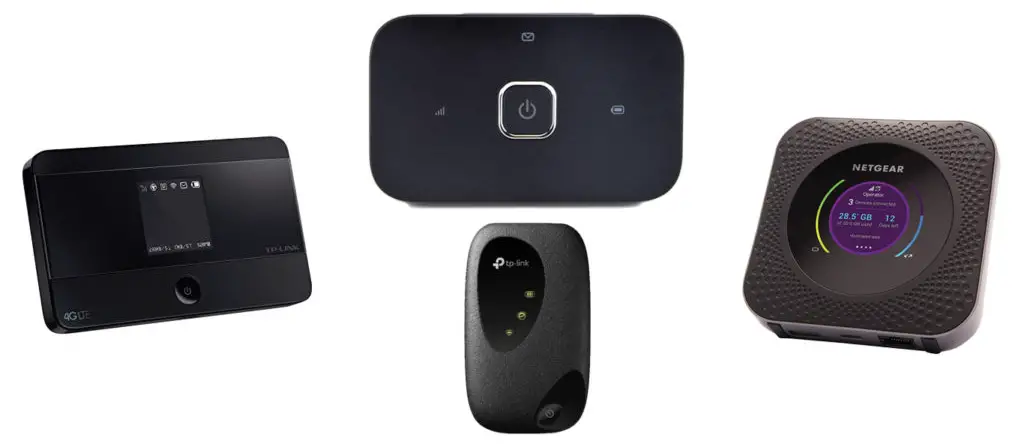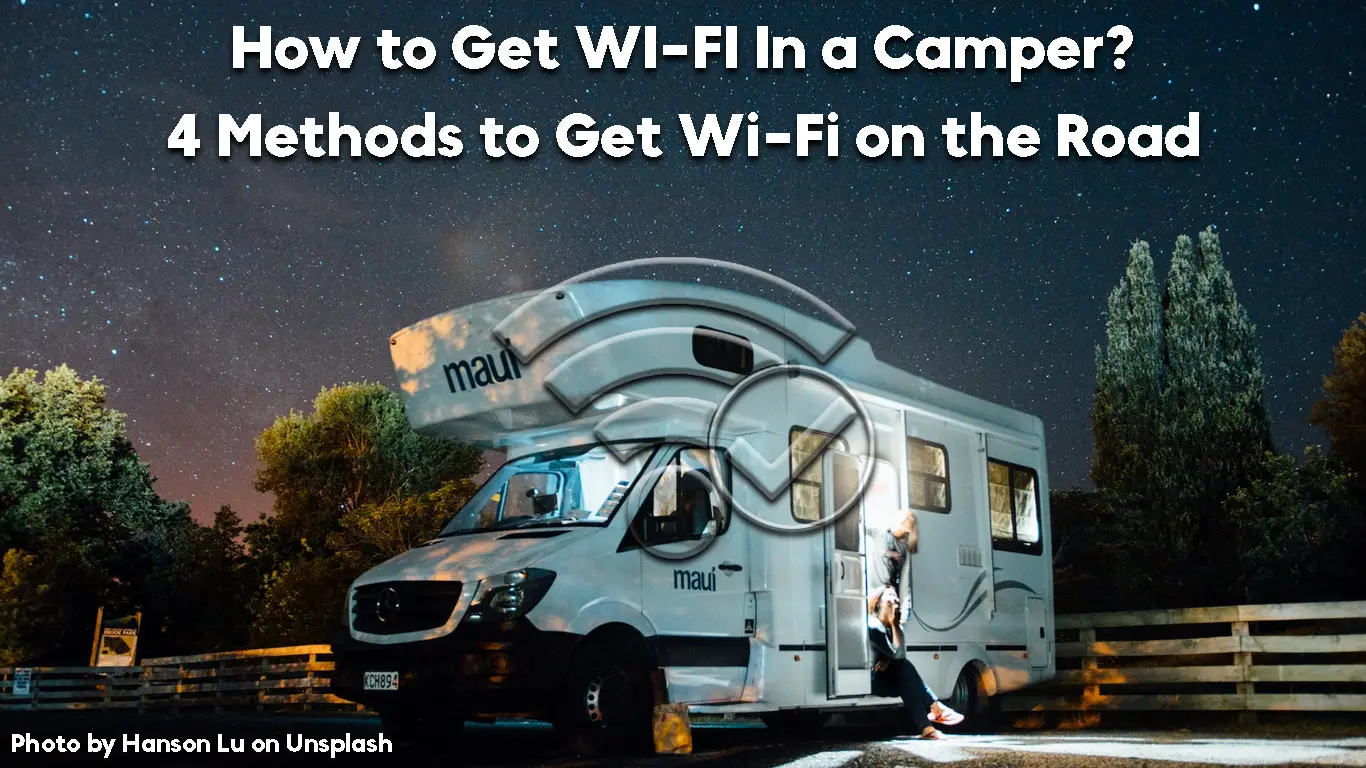For many campervan and RV owners, Wi-Fi is now more of a requirement than an added bonus. If you’re using your van to get away from it all and disconnect for a while, chances are the last thing you want or need is an internet connection.
However, when you’re living in your van long-term, your needs will be distinct. Perhaps you’ll need to work online, listen to music, watch movies on Netflix, etc. All these activities require a decent RV Wi-Fi connection.
To do common tasks such as checking your email or staying connected with loved ones on social media, you need a reliable internet connection. There are many ways to get Wi-Fi in a camper, but not all are created equal.
If you’re looking for a way to stay connected while on the road, this guide is here to provide tips on the best ways to get a reliable Wi-Fi connection in your campervan, no matter where you are.

CONTENTS
How to Get Wi-Fi in a Camper-Van
Getting Wi-Fi in a campervan can be easy or difficult, depending on a few factors. The type of campervan you have, your location, and your budget will all play a role in how easy it is for you to get connected.
The most important factor, however, is the type of internet connection you need. If you’re only looking for a connection to check your email or browse the web, you can get by with a much weaker connection than if you’re trying to stream video or work online.
Here are a few ways to get Wi-Fi in your campervan:
Use a Mobile Hotspot (MiFi Router)
A campervan Wi-Fi dongle, also called a MiFi router, or mobile Wi-Fi hotspot works similarly to your internet router at home. What sets it aside from a home router is that, instead of getting internet from a fiber optic cable or an ethernet cable in the ground, it has a built-in antenna that searches for 3G, 4G, or 5G signals from a cellular network tower.

Once the Wi-Fi dongle has located a signal, it will amplify it and broadcasts it as a Wi-Fi signal that you can tap onto with your mobile devices.
One of the many advantages of using a MiFi router is that it’s portable, and you can take it with you anywhere you go in your campervan. You’re not limited by where the nearest public Wi-Fi hotspot is or whether there’s an available Ethernet outlet.
NETGEAR M6 Mobile Hotspot Review
Another advantage of using a dongle is that it’s very easy to set up. You don’t need to be a tech expert to get it up and running – just follow the instructions that come with your device.
NETGEAR M6 Mobile Hotspot – Setup Instructions
The main downside of using a dongle is that you’re relying on the strength of the cellular signal in your area. If you’re in a remote area with spotty cell service, your Wi-Fi connection will be unreliable at best.
Additionally, dongles can be expensive – especially if you need a data plan with a high bandwidth allowance.
Use a Public Hotspot
If you don’t mind being tied to a specific location, you can always use a public Wi-Fi hotspot. Many camping grounds, restaurants, and coffee shops offer free Wi-Fi to their guests. This can be a great way to get a reliable and fast connection in your camper without having to worry about data limits or spotty service.
The advantage of using a public hotspot is that it’s usually free – or at least very cheap. The downside is that you’re limited to the areas where hotspots are available, and you may have to deal with slower speeds during peak times.
Additionally, public hotspots are generally less secure than private connections, so you’ll want to be careful about what kinds of activities you do online.
Staying Safe on Public Wi-Fi – Tips and Tricks
Use a Satellite Dish
If you’re planning to spend extended periods of time in rural areas or areas with spotty cell service, a satellite dish is your best bet for getting a reliable Wi-Fi connection.
Satellite dishes work by bouncing a signal off a satellite in space and down to a receiver on Earth. The receiver then amplifies the signal and broadcasts it as a Wi-Fi signal that you can connect your devices to.
Most satellite dishes come with a router that you can connect to the dish. This router will broadcast the Wi-Fi signal and allow you to connect multiple devices to it.
The main advantage of using a satellite dish is that you’re not limited by the strength of the cellular signal in your area. Whether you’re in the middle of nowhere or in a city with poor cell service, you’ll be able to get a strong and reliable Wi-Fi signal.
Another advantage of using a satellite dish is that you can get decent-speed internet – perfect for activities like streaming video or working online.
The main disadvantage of using a satellite dish is that the quality of the connection depends on many factors including the weather and obstacles between your dish and the satellite. So, if there are trees or other obstacles in the way, you won’t be able to get a great signal.
Another disadvantage of using a satellite dish is that it can be expensive. Satellite dishes can cost hundreds of dollars, and you’ll also need to pay for a monthly subscription.
If you’re looking for a reliable Wi-Fi connection while in a remote area and are willing to pay for it, a satellite dish is a great option.
Using Starlink Internet for a Camper/RV – Review
Use Your Phone as a Hotspot
If you have a data plan with your cell phone service, you can convert it into a Wi-Fi hotspot for your camper. Most phones have this feature built-in, and it’s usually very easy to set up.
All you need is to activate the mobile data feature and enable the hotspot feature on your phone.
Once you’ve done that, your phone will broadcast a Wi-Fi signal that you can connect your devices to.
The main advantage of using your phone as a hotspot is that it’s very convenient. You don’t need to worry about carrying around a separate device or setting up a complicated system.
Another advantage of using your phone as a hotspot is that you can take it with you wherever you go. If you’re moving from one campsite to another, you can just pack up your phone and go.
The main disadvantage of using your phone as a hotspot is that it can use a lot of data. If you’re not careful, you could easily exceed your data limit and rack up a huge bill.
Additionally, using your phone as a hotspot can drain the battery very quickly. If you’re planning to use your phone as a hotspot for an extended period of time, you’ll need to make sure it’s fully charged or have a backup battery.
Frequently Asked Questions
Question: What’s the best way to get internet in my RV?
Answer: There are several ways to get internet in your RV. You can use a mobile Wi-Fi hotspot, which is a small device that connects to the cellular network and creates a Wi-Fi signal you can connect your devices to. You can also use a satellite system, which uses a dish to connect to the internet, or you can use an RV park’s Wi-Fi if there is any available where you’re packed staying.
Best Internet Options for RV Living
Question: What is the cost of installing internet in an RV?
Answer: The price of RV internet varies depending on the method you choose. A mobile hotspot plans start at around $10 per month, while a satellite system can cost upwards of $100 per month. If you’re staying at an RV park that offers free Wi-Fi, the price will be included in your camping fees.
Question: How does RV internet work?
Answer: RV internet works in a similar way to home internet, but the methods of connecting to the internet are different. Mobile hotspots connect to the cellular network to create a Wi-Fi signal that you can connect your devices to. Satellite systems use a dish to connect to the internet, and RV parks usually have a Wi-Fi network installed that you can connect to with your devices.
Question: What kind of internet do I need for my RV?
Answer: The type of RV internet you need depends on how you want to use it. If you’re just using it for basic web browsing and email, then a mobile hotspot will be sufficient. If you want to use it for streaming videos, then you’ll need a more powerful connection like satellite internet.
Question: Can you get Wi-Fi without a plan?
Answer: In most cases, you will need some type of data plan to use Wi-Fi on your RV. However, there are some areas where you can get free or paid public Wi-Fi, such as RV parks, campgrounds, and coffee shops. You can also find free Wi-Fi hotspots by using a Wi-Fi Finder app on your smartphone.
Conclusion
There are several ways to get Wi-Fi in your camper. Each option has its benefits and drawbacks, so you should choose what works best for you personally.
If you’re looking for a cheap way to get Wi-Fi, using your phone as a hotspot or a mobile hotspot is convenient. If you want internet access in hard-to-reach areas and you need decent speeds, you could invest in an actual satellite dish.
Now that you know how to get Wi-Fi in your camper, you can feel more confident about tackling this project. If any questions come up, feel free to leave them in the comments section below!

Hey, I’m Jeremy Clifford. I hold a bachelor’s degree in information systems, and I’m a certified network specialist. I worked for several internet providers in LA, San Francisco, Sacramento, and Seattle over the past 21 years.
I worked as a customer service operator, field technician, network engineer, and network specialist. During my career in networking, I’ve come across numerous modems, gateways, routers, and other networking hardware. I’ve installed network equipment, fixed it, designed and administrated networks, etc.
Networking is my passion, and I’m eager to share everything I know with you. On this website, you can read my modem and router reviews, as well as various how-to guides designed to help you solve your network problems. I want to liberate you from the fear that most users feel when they have to deal with modem and router settings.
My favorite free-time activities are gaming, movie-watching, and cooking. I also enjoy fishing, although I’m not good at it. What I’m good at is annoying David when we are fishing together. Apparently, you’re not supposed to talk or laugh while fishing – it scares the fishes.

